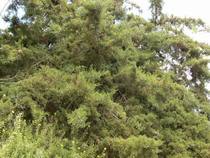
Permission: Some rights reserved
Grecian juniper
It is a large shrub or tree reaching 6-20 m tall , with a trunk up to 2 m diameter and a broadly conical to rounded or irregular crown. The leaves are of two forms, juvenile needle-like leaves 8-10 mm long on seedlings, and adult scale-leaves 0.6-3 mm long on older plants. It is largely dioecious with separate male and female plants, but some individual plants produce both sexes. The cones are berry-like, 6-11 mm in diameter, blue-black with a whitish waxy bloom, and contain 3-6 seeds; they are mature in about 18 months. The male cones are 3-4 mm long, and shed their pollen in early spring.Juniperus excelsa (Greek Juniper) is a juniper found throughout the eastern Mediterranean, from northeastern Greece and southern Bulgaria across Turkey to Syria and the Lebanon, and the Caucasus mountains. A subspecies, J. excelsa subsp. polycarpos, known as the Persian Juniper, occurs in the Alborz and other mountains of Iran east to northwestern Pakistan, and an isolated population in the Jebal Akhdar mountains of Oman; some botanists treat this as a distinct species Juniperus polycarpos, syn. J. macropoda. More
Juniperus excelsa Marschall von Bieberstein 1800 - Common Names Greek juniper (Vidakovic 1991); dhup (var. polycarpos, in India). Taxonomic notes Synonymy: * Juniperus sabina var. taurica Pall., Fl. Ross. 1789; * Juniperus sabina var. excelsa (M.-Bieb.) Georgi 1800; * Juniperus foetida var. excelsa (M.-Bieb.) Spach 1841; * Juniperus isophyllos K. More
Juniperus excelsa for £2. More
